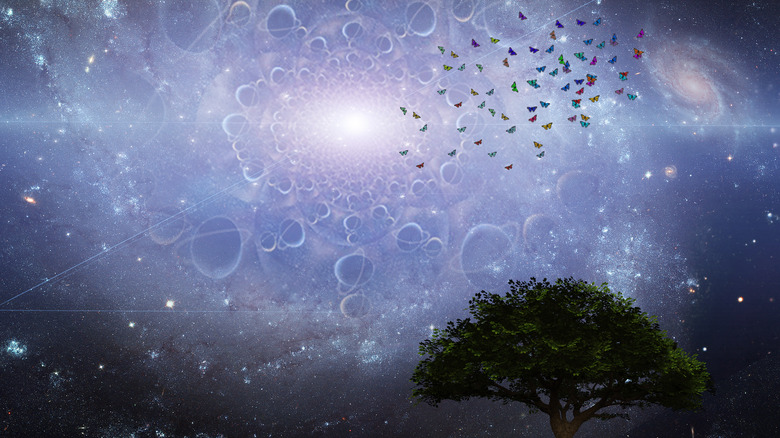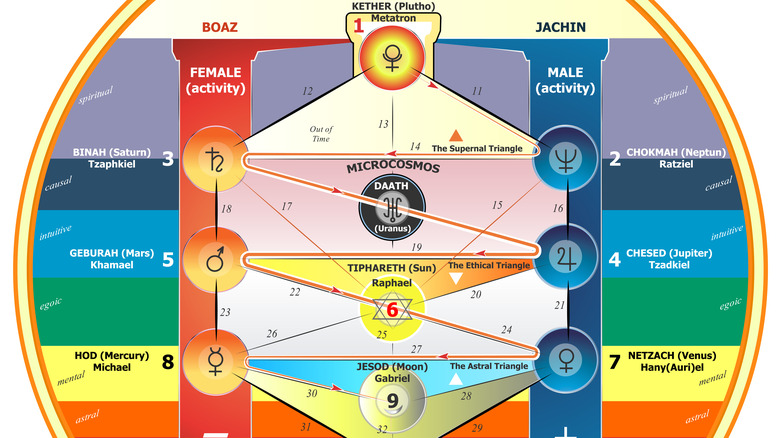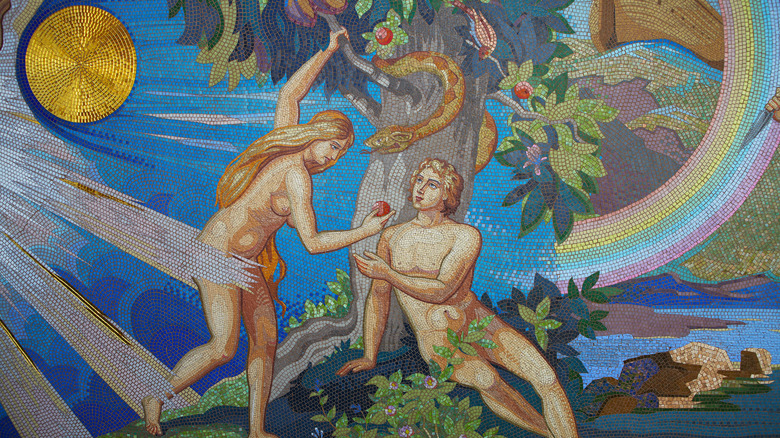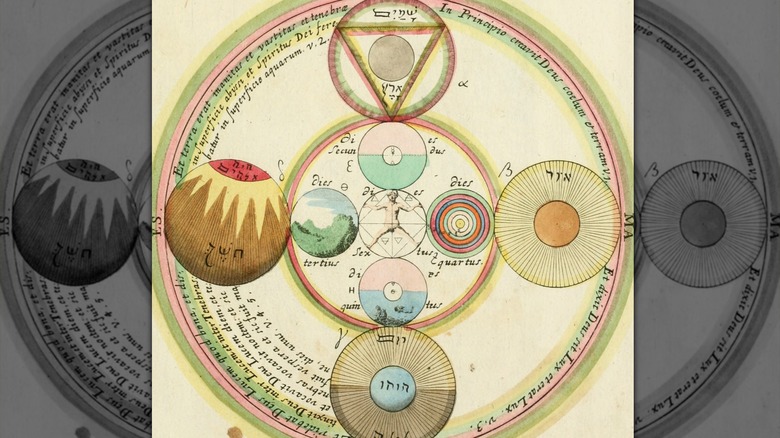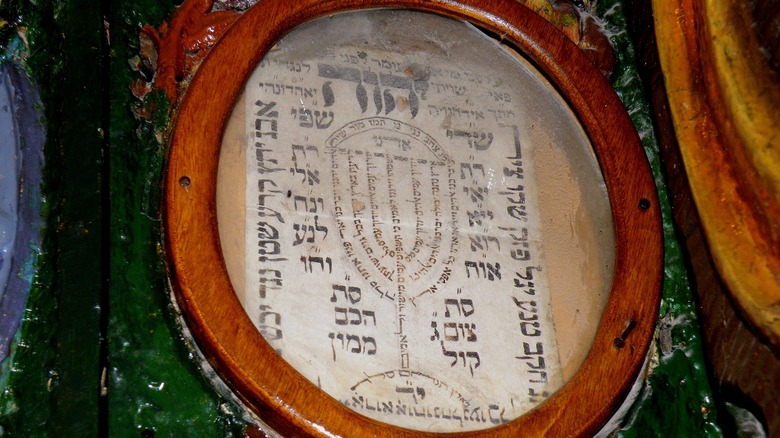Kabbalah: What Is The Meaning Behind The Tree Of Life?
Kabbalah is one of those belief systems that many people might recognize by name, only. Or at most, they might associate it with a story like that on the LA Times from about 20 years ago about Madonna dabbling in Kabbalah. And we use the vague, horribly defined term "belief system" on purpose, even though that's not wholly accurate. "Spiritual Master" Omraam Mikhaël Aïvanhov called Kabbalah "a very special science" that "requires special qualities" for "those who are predestined for it, who have the mental and psychic abilities," and "who possess moral qualities," as the Mandala Shop Online quotes. And if you can't tell from those sources and terms alone — spiritual master, psychic abilities, a mandala shop, etc. — Kabbalah dips its toes in a variety of mystical pools that might appeal to a wide swath of people.
As the Jewish Virtual Library explains, "Kabbalah" is actually a catch-all term for a host of ancient, esoteric Jewish mystical practices and studies. The Torah and the Bible's Old Testament define God's law for humanity, or "what it is God wants from man." Kabbalah, like a companion to such mainstream Judaism, attempts to divine the nature of God and the cosmos. Such lines of inquiry get really complicated, really quickly, as charts, diagrams, lists, and more on sites like Sefaria depict. But ultimately, Kabbalah boils down to the Tree of Life, a tree-shaped diagram that Kabbalists believe depicts the method that God employed to create the universe.
The Tree of Life's 10 Sephiroth
Discussions of Kabbalah's Tree of Life will likely leave many people scratching their head, as it's all extremely abstract. In fact, it's designed from the ground-up as a puzzle that a willing adherent spends a lifetime deciphering. But a Kabbalist wouldn't say Kabbalah is "designed" at all. They would just say, "That's the way the things are," and that Kabbalah is a tool for investigating reality. It opens the mind to deeper truths, allows people to glimpse cosmic secrets, etc., etc., rooted in the Tree of Life.
In general, Harreira describes the Tree of Life as composed of 10 nodes called "Sephiroth" that "symbolize the course that the God ascends from an infinite and unknowable being to the almighty creator of the universe." In other words, the Tree of Life is a kind of roadmap to enlightenment, and each Sephiroth is a waypoint. By starting at current human point X, people can reverse engineer the creation of the universe back to its original source: God.
Along those lines, Kabbalah Center says, "The Tree of Life is represented as ten stations of descending light that originate with the creator. Each of these stations, which are called Sephirot (Sephira, singular), is a cosmic principle and is approached through color, imagery, and sound." These principles relate to the 22-letter Hebrew alphabet, the 22 Major Arcana cards in the tarot, numerology, astrology, the chakra-like placement of Sephiroth throughout the body, and more. Like we said: It's complicated.
2 trees in the Garden of Eden
Before digging deeper into the Tree of Life's Sephiroth, it pays to answer a simple question: Why a tree? Trees do carry ultra-obvious symbolism: growth, branches, a central trunk, leaves and flowers, seeds, and so forth. Plenty of cultures around the world incorporate Trees of Life into their cosmogonies (universe origin stories), beliefs, tales of gods, etc. Norse mythology has Yggdrasil, Celtic mythology has a Tree of Life, Greek mythology has a World Tree extending through the planes of reality and which bears magic fruit, Chinese Daoist mythology has a magic tree bearing a magic pear, Egypt mythology has a Tree of Life with sacred vowels for each node just like Kabbalah, and more. In fact, Harreira describes Kabbalah as likely originating with Jews in Egypt, or at least having a common ancestry with Egyptian mysticism.
And of course, the Bible's Book of Genesis puts a Tree of Life in the Garden of Eden along with Adam and Eve. The Gospel Coalition reminds us that the Tree of Life was a second, separate tree aside from the Tree of the Knowledge of Good and Evil. This latter tree caused the fall of humanity, after which God, "placed the cherubim and a flaming sword that turned every way to guard the way to the tree of life." At a minimum, Kabbalah's Tree of Life connects Jews to this story in their cultural heritage and provides a symbolic way to contemplate it further.
From Malchut to Keter
As Kabbalah Experience explains, it's the layout of the Tree of Life's Sephiroth — its nodes — that really matters. These nodes can be grafted onto a human body and travel from the bottom to the top, feet to head. Each node represents a different facet of the human experience that progresses towards enlightenment through three key layers of nodes: instinct, emotion, and then intellect. Each layer also has three nodes, making it a triad. The instinct triad contains the nodes Yesod (Foundation), Hod (Surrender), Netzach (Victory). The emotion triad above them contains the nodes Tiferet (Beauty/Harmony), Gevurah (Strength), and Chesad (Love). The intellect triad above them contains the nodes Da'at (Knowing), Binah (Understanding), and Chochmah (Wisdom). Below them all is the lowest, single-node Malchut (Manifestation), while above them all is the highest, single-node Keter (crown). Twenty-two paths connect them all.
Looking at the Tree of Life, we can see that certain paths flow from one node to another, vertically and horizontally. This indicates how each Sephiroth relates to, and influences, those around it. The Tiferet Sephiroth, for instance — as the node of beauty or harmony — sits in the lower middle and binds many other nodes together. Similarly, the top node Keter represents "superconsciousness," or the "ultimate unseen reality." As stated, each node also corresponds to a different color, sound in the Hebrew alphabet, and more. Neohasid discusses the Sephiroth in greater detail, while Sefaria connects each to specific planets and chakras.
[Featured image by Internet Archive Book Images via Wikimedia Commons | Cropped and scaled]
The 4 trees of the godhead
Lest the reader think that the Kabbalistic Tree of Life is a direct copy-paste from ancient sources, Kabbalah Experience says that the tree's current layout and naming conventions date back to France in the 12th century. This jives with the Jewish learning site Chabad's Kabbalah Online overview page, which explains that Rabbi Moshe de Leon started sharing Kabbalah's main text the Zohar in the early 1300s. The Zohar apparently dates back to 170 to 200 C.E., when Rabbi Shimon bar Yochai compiled it while hiding in a cave from Roman authorities. But given all the purple language and overtly religious sentiment surrounding the Zohar, Kabbalah, and the Tree of Life, it's difficult to approach such claims as absolute fact.
Regardless, the Tree of Life stands as an important gateway for Jews and non-Jews alike to learn more about some of the lesser-known facets of Judaism's history. Beyond the basics covered in this article, Sunny Ray says that there are actually four Trees of Life or four cosmic realms through which the Tree of Life can be glimpsed differently: Asiyah (our physical world), Yetrizah (the "formative world" of angels), Beriah (the "creative world" of archangels), and Atzilut (the cosmic source world). Harreira says that adherents "loop" through one Keter (crown) after another at the top of each tree, and in the end finally arrive at God. In other words, the curious better get going, because enlightenment is going to take quite some time.
[Featured image by Roy Lindman via Wikimedia Commons | Cropped and scaled | CC BY-SA 3.0]
